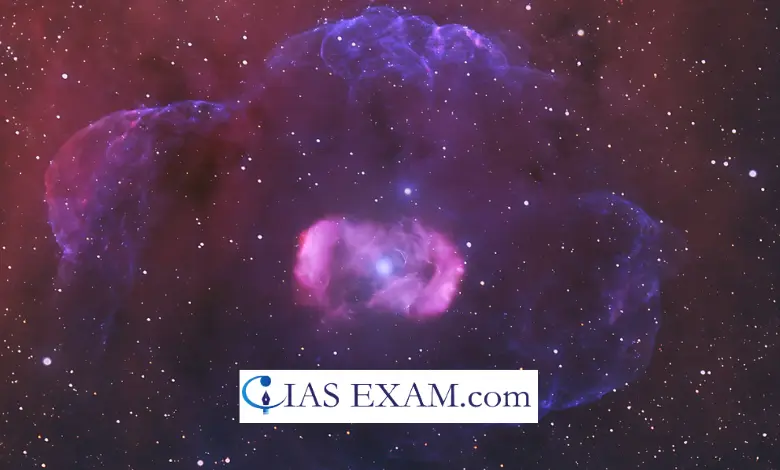
Context
The Dragon’s Egg nebula, also known as the NGC 6164/6165, a cloud of gas and dust surrounding a pair of stars called HD 148937, have recently presented a puzzle to astronomers.
About
- A nebula is a massive, expansive cloud of gas and dust that is placed for the duration of the universe.
- This celestial formation is available in a variety of shapes, sizes, and colorings, each with its own specific characteristics and story to inform.
- At its middle, a nebula consists by and large of hydrogen and helium, the 2 most considerable elements inside the universe.
- These gases intermingle with strains of heavier elements, consisting of carbon, nitrogen and oxygen, which have been solid in the hearts of historic stars.
- A nebula serves as the birthplace of stars.
- Within this cosmic cloud, gravity works tirelessly to pull the gasoline and dust together, slowly compressing the fabric into increasingly more dense clumps.
- As those clumps develop in mass and density, their cores start to heat up, sooner or later achieving temperatures excessive enough to ignite nuclear fusion.
- At this factor, a new famous person is born, illuminating the encompassing nebula with its intense radiation.
- A nebula performs a vital function within the life cycle of stars and galaxies.
- As stars shape within this cosmic cloud, they steadily burn up the encompassing gas and dust, using it as fuel for their nuclear reactions.
- Over hundreds of thousands or billions of years, the most big stars explode as supernovae.
What is the Dragon’s Egg Nebula?
- The Dragon’s Egg Nebula formed as a result of the intense stellar winds emanating from a large, hot central star.
- NGC 6164/6165 includes awesome regions: NGC 6164, which represents the brighter, extra compact location surrounding the central big name, and NGC 6165, which extends outward in a chain of complex filaments and bubbles.
- These two regions work together to create the nebula’s basic shape, which resembles a dragon’s egg – consequently its popular name.
- The best views of NGC 6164/6165 come from effective telescopes, which include the Hubble Space Telescope or the European Southern Observatory’s Very Large Telescope.
Unique Features of the NGC 6164/6165
- These two stars – gravitationally sure to each other in what’s referred to as a binary system – are placed in our Milky Way galaxy about 3,700 light-years from Earth in the constellation Norma.
- A light-year is the distance light travels in a yr, 5.9 trillion miles (9.5 trillion km).
- One of them has a magnetic field (as does our sun), while its companion does not.
- The magnetic star is about 30 times more massive than the sun. Its remaining companion is about 26.5 times more massive than the sun.
- They orbit at a distance from each other varying from seven to 60 times the distance between Earth and the Sun.
Significance of the Dragon’s Egg Nebula – A Window to Our Universe
- The Dragon’s Egg Nebula serves as a reminder of the vastness and wonder of the universe. It represents simply one of endless cosmic marvels ready to be found and understood.
- As astronomers preserve to observe NGC 6164/6165 and different celestial items, they free up the secrets of the cosmos and enlarge our know-how of the fundamental strategies that form the universe.
- Through the lens of the Dragon’s Egg Nebula, one can catch a glimpse of the intricate dance between stars, gas, and dust that plays out on a grand scale.
Source: The Indian Express





.png)



